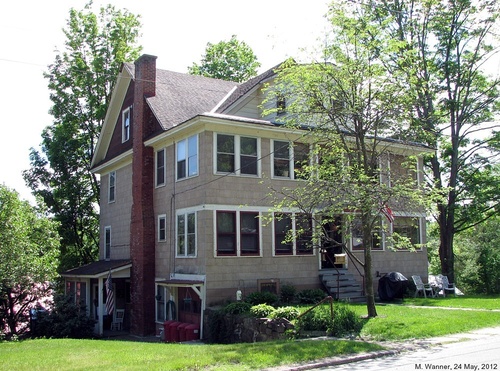 Hop House
Hop House 74 Bloomingdale Avenue looking towards Broadway, 1930s
74 Bloomingdale Avenue looking towards Broadway, 1930s
The Hop House is at far right.
Address: 44 Marshall Street
Old Address: 27 Marshall Street
Other names: Harvey House, an apartment building for veterans, supported by St. Joseph's Addiction Treatment and Recovery Centers.
Year built:
This building, later converted with porches for curing use and now apartments, is said to have been Ensine Miller's hop barn. It would not be surprising to find that Julia Miller, who developed the farm she inherited from him into that whole lower Park Avenue neighborhood, had made the conversion.
"Hops, a perennial flowering vine that gives beer its bitter taste, was a staple crop in Franklin County for over 100 years. The commercial growing of hops began in 1825. . . . Hops were dried in hopkilns, large heated barns, and shipped to Montreal and NYC brewers. In 1880 the county produced 1,083,850 lbs. of hops. Production declined in NY in the late 1880s. . . . Demand dropped during Prohibition and finally tapered off." 1
"New York played a prominent national role in hop agronomy. In the 19th century, hop houses were so common in central New York that it was said that 'every other farm and farmer had one.' Constructed between the early 1800s and 1900" in at least six central New York counties, "hop houses evolved from low-slung barns with ventilation to unique pyramid-shaped kilns that made cultivation and drying more efficient." Ensine Miller's hop house on Marshall Street appears to be of the earlier type. "Due to excellent yields and good market prices, central New York hop production assumed major proportions by mid-century. By 1879, central New York's hop fields covered over 40,000 acres and produced over 20,000,000 pounds. At its peak in the last quarter of the 19th century, the American brewing industry consumed more than 30,000,000 pounds of dried hops each year—the majority grown in central New York." For a time, hops were an important Franklin County crop. "But by 1900, central New York's golden age of hops was over, due to a combination of events: competition from more efficient producers in Oregon, California and Washington; crop-specific insects and 'blue mold' that attacked and destroyed the hop flower; the emergence of the more reliable dairy industry; and a growing intolerance toward alcohol. Prohibition in the 1920s and '30s brought on the final collapse of what had been central New York's most successful crop." 2
Adirondack Daily Enterprise, February 8, 2019
Apartments for veterans debated, approved
by Jesse Adcock
[A full description of the proposal}
Comments
Footnotes
1. "Adirondack Stories, Historical Sketches" (column) by Marty Podskoch and Sam Glanzman, Adirondack Daily Enterprise, April 9, 2013.
2. "When Hops Were King," New York Archives, Fall 2006.



